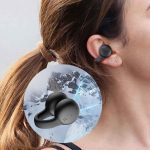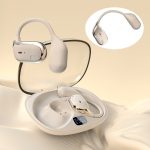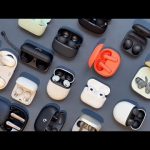سماعات الرأس جزء من أزياء الأطفال الحديثة. لقد دخلت الأدوات بقوة في ثقافتنا. وكلما زاد تعرضك للمخاطر، زادت احتمالية قبولك لها ومسايرة الموضة. يمكن لسماعات الأذن التي تلائم الأذن بشكل مريح أن تخلق مظهرًا عصريًا بمنتج بسيط. في الوقت نفسه، سيحتاج طفلك إلى استخدام سماعات الرأس للوصول إلى الوسائط المختلفة. يعد اللعب السريع جزءًا مهمًا من حياة طفلك، سواء كانت الموسيقى أو الأفلام. ولكن، هل هي آمنة؟ ربما سمعت الكثير عن مخاطر الإشعاع على السمع والقدرات الإدراكية. وفي بعض الحالات، سيتجاوزها الطفل مع تقدمه في العمر. في هذه المقالة، يتم توضيح السلامة فيما يتعلق باستخدام سماعة الرأس لأطفالك.
الفصل 1: هل يمكن للأطفال استخدام سماعة الرأس؟
الفصل 2: هل من الضروري أن يرتدي الأطفال سماعات الرأس؟
الفصل 3: كيف تختار سماعات الرأس الآمنة للأطفال؟
الفصل 4: يجب الحذر من استخدام سماعات الرأس أثناء السماح للأطفال
الفصل 5: سماعات الرأس السلكية أم اللاسلكية أيهما يجب أن تشتري لطفلك؟
الفصل 6: هل يمكن للأطفال ارتداء سماعات الرأس؟
الفصل 7: هل سماعات الأذن الخاصة بالأطفال ضارة بسماع الأطفال ودماغهم؟
الفصل 8: مشكلة عدم وجود داء المبيضات
الفصل 9: المشاكل النفسية للطفل
الفصل 10: حجم الاستماع التعويضي
الفصل 11: الحجم مهم
جدول المحتويات
تبديلالفصل 1: هل يمكن للأطفال استخدام سماعة الرأس؟
يرغب العديد من الآباء في إبقاء أطفالهم مشغولين أثناء السفر أو القيادة. ولا ينتبهون إلى تركيبتها. تختلف سماعات الرأس للأطفال عن سماعات الرأس للبالغين. آذان الأطفال حساسة جداً ويمكن أن تسبب الموسيقى الصاخبة فقدان السمع.
الفصل 2: هل من الضروري أن يرتدي الأطفال سماعات الرأس؟
تتمتع سماعات الرأس بالعديد من المزايا، ويمكنها تحسين الحالة البدنية لطفلك بشكل كبير. هناك وظيفة كتم الضوضاء بالنسبة لسماعات الرأس للأطفال وهي مكمل رائع لآذانهم. عندما تكون في الخارج، يمكن أن تزعج الإشارة المستمرة سمعك في بعض الأحيان. يمكن حماية هذه الضوضاء باستخدام سماعات الرأس. في أي يوم من الأيام، يُفضل استخدام سماعات الرأس. الرنين الداخلي لديه القدرة على إلحاق الضرر بطبلة الأذن. تتضمن سماعات الأطفال، على عكس سماعات الرأس، تحكماً مدمجاً في مستوى الصوت. ونتيجة لذلك، يمكنك التحكم في مستوى الصوت بمقبض واحد فقط.
الفصل 3: كيف تختار سماعات الرأس الآمنة للأطفال؟
ضع ذلك في اعتبارك عند اختيار سماعات الرأس لطفلك.
حجم سماعة الرأس- يجب أن يكون حجم سماعة الرأس مثاليًا. توضع بشكل مريح على رأس طفلك، وتغطي أذنيه، ولا تكون ضيقة جداً أو فضفاضة جداً.
تدوم لفترة أطول- البقاء لأطول فترة ممكنة يميل الأطفال إلى كسر الأشياء عمداً. لذا اختر واحدة تدوم لفترة أطول.
تحديد احتياجات طفلك- كثيراً ما يتم تضمين الأطفال الذين يعانون من عسر القراءة أو أولئك الذين يتناولون أدوية سامة للأذن. ستحتاج إلى العثور على سماعات إلغاء الضوضاء.
تقليل الضوضاء- من الجيد عادةً شراء سماعات الرأس بعد فحص ميزاتها الصوتية. لتجنب تعريض طفلك الصغير لمستويات ضوضاء عالية، احصل على مستوى ضوضاء مرتفع.
التصميم- يريد الأطفال شيئاً مميزاً. يجب أن تكون سماعات الرأس جذابة من حيث التصميم واللون. أيضًا، إذا كانت مريحة، ارتدِ زيًا موحدًا. وإلا فقد يفقد طفلك اهتمامه بسرعة.
الفصل 4: يجب الحذر من استخدام سماعات الرأس أثناء السماح للأطفال
على كل حال، هناك بعض الخطوات التي يجب عليك اتخاذها قبل أن تتمكن من السماح لطفلك بالرقص على الموسيقى بسماعاته. يكون الصوت مرتفعاً جداً عند الاستماع إلى الموسيقى على مسافة أمتار.
تعرّف على إعدادات مستوى الصوت:
إذا كان لديك خيار ضبط الحد الأقصى لمستوى الصوت، فافعل ذلك وحافظ على مستوى الصوت آمنًا. اجعل طفلك يأخذ استراحة استماع كل ساعة. أخبر الأطفال عن الأضرار المحتملة على سمعهم.
الفصل 5: سماعات الرأس السلكية أم اللاسلكية أيهما أشتري لطفلي؟
سماعات الرأس اللاسلكية هي الأفضل. يرجى ملاحظة أن الجهاز اللاسلكي قد يحيط بطفلك أثناء عمله. من ناحية أخرى، تعاني السماعات اللاسلكية من مشاكل في الجودة إذا تم وضعها بعيداً جداً عن الجهاز. إذا كنت ترغب في مواكبة أحدث الأنماط، فإن سماعات البلوتوث هي خيار جيد.
الفصل 6: هل يمكن للأطفال ارتداء سماعات الرأس؟
نعم، يمكن ارتداء سماعات الرأس إذا تم اتباع جميع احتياطات السلامة. مع سماعات الرأس المصممة خصيصاً، يمكنك ضمان تشغيل موسيقى عالية الجودة أثناء الرعاية. يمكن أن يكون النوع المناسب من سماعات الرأس آمنًا لطفلك إذا كانت هناك قواعد لاستخدامها. لتجنب تلف الأذنين، لا تدع الأطفال يستمعون إلى الموسيقى طوال اليوم. عندما يتعلق الأمر بسماعات الرأس، يجب أن تكون أكثر حذراً عندما يتعلق الأمر بالأطفال. لا تعرض سلامة طفلك للخطر بالسماح لطفلك باستخدام سماعات الرأس.
الفصل 7: هل سماعات الأذن الخاصة بالأطفال ضارة بسماع الأطفال ودماغهم؟
من الشائع هذه الأيام أن يكون لدى الأطفال الصغار وحتى الصغار برامج الترفيه الخاصة بهم. قد لا يدرك الآباء والأمهات أن جهاز التابلت أو الهاتف المزود بالرسوم المتحركة وسماعات الرأس قد يجنبهم الغضب خاصة أثناء السفر، وقد يتفهمون سبب رغبتهم في إسعاد أطفالهم. قد لا يدرك الآباء والأمهات أن أطفالهم قد يُحكم عليهم بالسجن مدى الحياة بسبب فقدان السمع الناجم عن الضوضاء (NIHL). وللتوضيح، لديك حوالي 15,000 خلية شعر حساسة عند الولادة. العدد الذي ولدت به هو العدد الوحيد الذي يمكنك الحصول عليه. لن تعطيك هذه الخلايا أي شيء ولن تنمو مرة أخرى. توقف الإصابة انتقال الصوت إلى الدماغ، مما يسبب فقدان السمع ومشاكل أخرى.
الفصل 8: مشكلة عدم وجود داء المبيضات
تكمن مشكلة ضعف السمع غير الحاد في أنه يبدأ في الحدوث قبل أن تدرك ذلك. فهو ليس تغيرًا مفاجئًا من السمع إلى عدم السمع، ولكنه عبارة عن تغيرات صغيرة تتشكل تدريجيًا بمرور الوقت تؤدي إلى فقدان حاسة مهمة من حواس الحياة والتواصل. عندما يتعرض الأطفال للأصوات الضارة لا يؤثر ذلك على سمعهم فحسب، بل على نموهم أيضًا. يمكن أن يؤثر فقدان السمع غير المبرر على قدرة الطفل على فهم الكلام ويمكن أن يكون عائقًا مهمًا أمام التعلم.
Cالفصل 9: المشاكل النفسية للطفل
كما يمكن أن يسبب للطفل مشاكل نفسية تؤثر على تواصله مع أصدقائه وقراءته وانتباهه في المدرسة والمجتمع ككل. لا يجب عليك أن تمنع طفلك من استخدام أحدث التقنيات. ولكن هناك بعض الخطوات العملية التي يمكنك اتخاذها لضمان عدم تضرر سمع طفلك:
أولاً، فكر في مقدار الوقت الذي يحصل فيه طفلك على سماعات الرأس في المنزل والذهاب إلى المدرسة. توصي الإرشادات بما لا يزيد عن 60 دقيقة في اليوم عند 60% من الحد الأقصى للصوت. قد تحتاج أيضًا إلى مراجعة مدرسة طفلك لمعرفة مقدار الوقت المتاح لسماعات الرأس وما إذا كانت توفر الحماية. إذا كان الجهاز يحتوي على مفتاح لمستوى الصوت، فقم بإغلاقه عند حوالي 60% من مستوى الصوت بحيث لا يستطيع طفلك تجاوز هذا المستوى. هذا هو المستوى المرجعي الوحيد لأنه سيختلف من جهاز إلى آخر وكذلك من جهاز إلى آخر وكذلك من جهاز إلى آخر ومن سماعات الرأس. ضع في اعتبارك المنطقة التي يستمع فيها الطفل، فإذا كانت هادئة فمن الأفضل استخدام سماعات الأذن، أما إذا كانت صاخبة فلن تعمل لأنها ستسرب الصوت خلف الأذن وسيظهر طفلك تلقائياً.
الفصل 10: حجم الاستماع التعويضي
في البيئة الصاخبة، استخدم سماعات الرأس التي توضع فوق سماعات الرأس التي تقلل من الضوضاء في الخلفية وتسمح بصوت أفضل بصوت منخفض. إذا كان طفلك يرتدي سماعات الرأس، يُرجى التأكد من الحفاظ على سلامته لأنه لن يعرف ما يدور حوله/ حولها. ضع في اعتبارك شراء سماعات رأس للأطفال تأتي مع حد أعلى لمستوى الصوت. سوف تتأكد من أن طفلك لن يتجاوز المستوى الذي حددته الشركة المصنعة. ضع في اعتبارك تنزيل تطبيق حماية الأذن الذي يتيح لك التحكم في مستوى تعرض طفلك وأوقات الاستماع عن بُعد. لكن في النهاية، يعود في النهاية إلى الوعي.
بصفتك أحد الوالدين، يجب عليك معرفة مدى تعرض طفلك للضوضاء الصاخبة والتحكم في مدى تعرضه لها والتأكد من القيام بأمور لمنع مستويات الاستماع المفرطة أو الطويلة لتجنب أي ضرر دائم على أذني طفلك. تأتي معظم بيانات فقدان السمع على المدى الطويل من دراسات التعرض للضوضاء في مكان عمل البالغين. تعادل 8 ساعات من التعرض لـ 85 ديسيبل (ديسيبل) من الضوضاء ما يعادل ازدحام المطاعم أو الازدحام. لذلك، قد يكون من الخطورة أن يستمع طفلك إلى الأفلام أو الموسيقى أو ألعاب الفيديو في نفس الوقت أو طوال اليوم معًا بمستوى صوت يبلغ 85 ديسيبل أو أكثر في ذلك الوقت.
الفصل 11: الحجم مهم
يمكن سماع مستويات الضوضاء التي تقل عن 70 ديسيبل (التي تقابل الضوضاء التي تسمعها عند القيادة بسرعات عالية) لفترة طويلة دون خطر. أما الضوضاء التي تزيد عن 100 ديسيبل فيمكن أن تسبب ضرراً دائماً في دقائق. أما الضوضاء التي تزيد عن 125 ديسيبل (التي يمكن أن تسمعها في حفل موسيقي صاخب أو سباق سيارات بدون سدادات الأذن) فيبدأ الضرر في ثوانٍ وقد لا يمكن إصلاحه.
الأطفال دون سن الخامسة لديهم آذان أقصر من الأطفال والبالغين، لذلك يتم تضخيم الضوضاء. كما يشرح تشانغ، في الصوتيات، عادةً ما يكون حجم الصوت في المساحة الصغيرة المغلقة كبيراً. ووفقًا له، فإن أخصائيي السمع يدفعون دائمًا الفرق في حجم قناة الأذن عند ارتداء المعينات السمعية. ويمكن تطبيق المفهوم نفسه على استخدام سماعات الرأس ومستوى الصوت. كل هذا يشير إلى أنه يجب توخي الحذر بشكل خاص لتقليل تعرض الرضع والأطفال الصغار ومرحلة ما قبل المدرسة للضوضاء الصاخبة.
الخاتمة
قد يكون من الآمن للطفل استخدام سماعات الرأس أو سماعات الأذن حسب مستوى الصوت وطول الاستماع وحجم الصماخ الصوتي. لن يتضرر استماع الطفل على الأرجح إذا تنافس استماع الطفل على موسيقى واحدة بمستوى صوت أعلى. ومن ناحية أخرى، قد يكون الاستماع لفترات طويلة بمستوى صوت مرتفع ضاراً بالسمع. تساهم كل هذه الأمور في القرارات التي يتخذها الناس عند شراء سماعات الرأس للأطفال. قد تكون جودة الصوت الجيدة مع التحكم في مستوى الصوت هي كل ما يريده طفلك، ولكن قد يكون الهيكل المقاوم للماء أو السعر المناسب للميزانية مهمًا جدًا بالنسبة لك. قد يكون من الآمن للطفل استخدام سماعات الرأس أو سماعات الأذن حسب مستوى الصوت وطول الاستماع وحجم الصماخ الصوتي. يمكن أن تقدم Sonun سماعات الرأس للأطفال بعلامات خاصة مخصصة. فقط اذهب هنا للتحقق من المزيد عن سماعات الأطفال.




